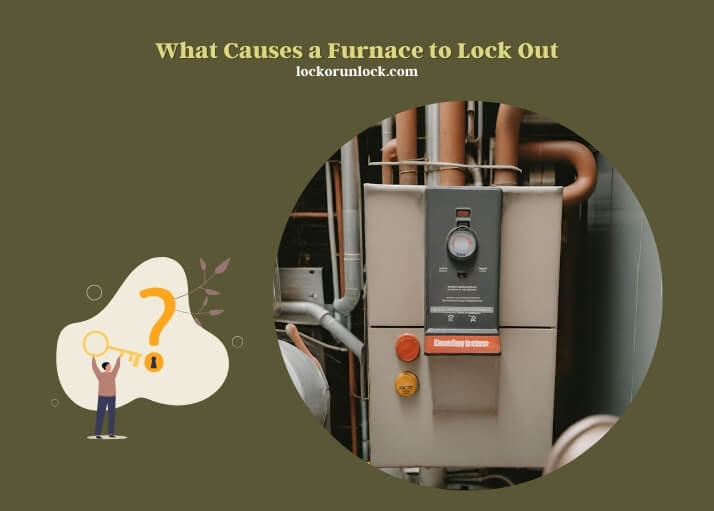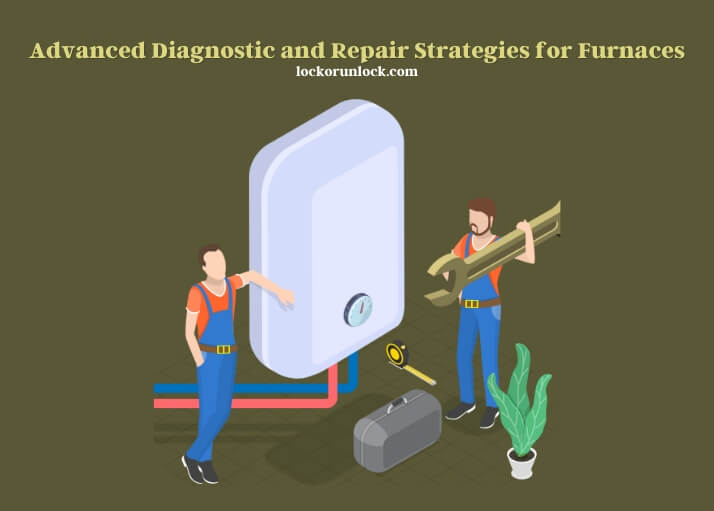A furnace locks out due to safety concerns or system malfunctions. Common causes include overheating, flame failure, electrical issues, and pressure switch problems.
Furnace lockouts serve as a protective measure to prevent damage to the system and ensure household safety. Overheating, one of the primary reasons, can occur from restricted airflow, necessitating regular filter changes and system maintenance. Flame sensor dirt accumulation is another significant factor; it requires periodic cleaning to ensure the furnace operates efficiently. Electrical issues, such as faulty wiring or tripped circuit breakers, disrupt the power supply, leading to system shutdowns.
The pressure switch, a critical component, monitors the furnace’s ventilation. If it detects an unsafe operating condition, it will trigger a lockout. Insufficient gas pressure also causes lockouts, as the furnace cannot maintain a stable flame under these conditions.
These issues promptly can help avoid the inconvenience of unexpected furnace shutdowns and maintain a comfortable and safe home environment. Regular inspections and maintenance by professionals play a crucial role in identifying and rectifying potential problems, ensuring the furnace runs smoothly throughout the colder months.

Key Reasons for Furnace Lockout and Solutions
A furnace lockout can be a frustrating experience, especially during cold weather. The primary causes include dirty air filters, neglected maintenance, and faulty flame sensors. Dirty air filters restrict airflow, causing the furnace to work harder and eventually shut down to prevent damage.
Regular maintenance is crucial to ensure all components function correctly and efficiently. Faulty flame sensors, which detect whether the flame is lit, can also lead to lockouts if they fail to sense the flame correctly, assuming the furnace is not igniting as it should.
These issues involves checking and replacing air filters regularly, scheduling annual maintenance checks, and cleaning or replacing the flame sensor as needed. These steps can significantly reduce the likelihood of furnace lockouts, ensuring a warm and comfortable home environment.
Thermostat Settings’ Influence on Furnace Operation
Thermostat settings play a vital role in furnace performance. Incorrect settings or compatibility issues can cause the furnace to cycle too frequently or not enough, leading to lockouts. Ensuring the thermostat is correctly calibrated and compatible with your furnace is essential for optimal performance.
Regular recalibration and updating thermostat firmware can also help maintain efficient furnace operation. Implementing energy efficiency tips, like setting the thermostat to a lower temperature when the house is empty, can also prevent unnecessary strain on the furnace.
Electrical Complications and Furnace Lockout
Electrical issues, such as tripped circuit breakers, blown fuses, and wiring problems, are common culprits behind furnace lockouts. These problems can interrupt the power supply to the furnace, preventing it from operating.
Regular inspections can identify and rectify these issues before they lead to a lockout. Implementing preventive measures, like ensuring the electrical system is up to code and replacing old wiring, can minimize the risk of electrical faults.
Fuel Supply’s Role in Furnace Efficiency
The efficiency of a furnace heavily depends on a consistent and clean fuel supply. Obstructions in gas lines or issues with fuel quality can cause the furnace to operate inefficiently or not at all, leading to lockouts.
Conducting regular inspections and safety checks can ensure the fuel supply is uninterrupted and meets the furnace’s requirements. Addressing any obstructions or quality issues promptly can restore furnace efficiency and prevent lockouts.
Advanced Diagnostic and Repair Strategies for Furnaces
Leveraging advanced diagnostic tools and techniques can pinpoint the exact cause of furnace lockouts. While some homeowners may attempt DIY repairs, complex issues often require the expertise of a certified technician.
A professional can offer a cost-benefit analysis of repairs versus replacement, ensuring homeowners make informed decisions about their heating systems. Finding a reputable and certified technician is crucial for effective and efficient furnace repairs.

Common Furnace Problems and Solutions
| Problem | Solution |
| Dirty air filter | Replace or clean the air filter |
| Faulty flame sensor | Clean or replace the flame sensor |
| Incorrect thermostat setting | Adjust the thermostat or consult a professional |
Average Costs for Furnace Repair Services
| Service Type | Average Cost |
| Basic maintenance | $50 – $200 |
| Flame sensor repair | $80 – $250 |
| Electrical repairs | $100 – $400 |
Frequently Asked Questions (FAQs)
Can Overheating Cause Furnace Lockout?
Overheating is a prevalent issue that can lead to a furnace locking out. This typically occurs when the furnace’s internal temperature exceeds safe limits, prompting the system to shut down to prevent damage. Overheating can be caused by restricted airflow due to a clogged filter, blocked vents, or a malfunctioning blower motor.
It’s essential to ensure proper airflow and to replace or clean air filters regularly. If overheating issues persist, it may indicate a more serious problem requiring professional attention. Regular maintenance checks can help identify and mitigate factors contributing to overheating, ensuring the longevity and efficiency of your furnace.
Does a Faulty Thermostat Wire Cause Furnace Lockouts?
Faulty thermostat wiring is a less obvious but significant cause of furnace lockouts. Incorrect or damaged wiring can disrupt communication between the thermostat and the furnace, leading to erratic behavior or a complete system shutdown. Symptoms of this issue include the furnace not starting, stopping unexpectedly, or the thermostat losing power.
To diagnose and fix wiring problems, it’s often necessary to consult with a professional HVAC technician. They can test the thermostat wires, ensure proper connections, and replace any damaged wiring, restoring the system’s functionality and preventing future lockouts.
Can a Dirty Flame Sensor Trigger a Furnace Lockout?
A dirty flame sensor is a common culprit behind furnace lockouts. The flame sensor’s role is to confirm that the furnace is firing correctly. If it’s coated in soot or debris, it may fail to detect the flame, causing the furnace to shut down as a safety measure.
Cleaning the flame sensor is a straightforward task that involves gently removing the buildup with a soft cloth or a special brush designed for this purpose. Regular cleaning of the flame sensor can prevent lockouts and ensure the furnace operates safely and efficiently.
Impact of High Limit Switch Failure on Furnace Operation
The high limit switch is a critical safety device in furnaces that prevents overheating by shutting down the furnace if the air inside the plenum gets too hot. Failure of this switch can lead to continuous operation without regulation, causing severe overheating and potential damage to the furnace components.
This condition often results in a lockout to prevent unsafe operating conditions. Diagnosing a faulty high limit switch requires technical knowledge to test its continuity and functionality. Replacing a malfunctioning high limit switch is crucial for maintaining safe furnace operation and preventing lockouts due to overheating.
How Can Pressure Switch Problems Cause Furnace Lockouts?
The pressure switch in a furnace ensures that there is enough airflow for safe operation before allowing the furnace to ignite. Problems with the pressure switch, such as blockages in the vent pipes or a malfunctioning switch, can prevent the furnace from starting.
A furnace might lock out if the pressure switch is stuck open or closed, signaling an airflow problem or a failure in the exhaust system. Regular inspection and cleaning of the vent pipes, along with testing the pressure switch for proper operation, can help avoid lockouts related to pressure switch issues.
Does Insufficient Gas Pressure Lead to Furnace Lockouts?
Insufficient gas pressure can indeed cause a furnace to lock out. The furnace requires a specific range of gas pressure to operate efficiently and safely. If the gas pressure is too low, the furnace may fail to ignite, or it might shut off shortly after starting.
Factors contributing to low gas pressure include issues with the gas line, such as leaks or blockages, or problems with the gas supply from the utility company. It’s vital to have a professional technician assess and resolve gas pressure issues to ensure the furnace operates reliably and to prevent lockouts due to insufficient gas supply.
Summary
Furnace lockouts can be caused by a variety of issues, from maintenance neglect to electrical problems. Addressing these issues promptly can prevent the inconvenience of a furnace lockout. Regular maintenance, correct thermostat settings, ensuring a clean fuel supply, and addressing electrical issues are key to maintaining furnace efficiency. For complex problems, consulting a professional technician is advisable.
